Amazon FBA and dropshipping are two ecommerce business models that are seemingly very similar, but have small details that make huge differences when it comes time to actually running and growing profitable internet brands.
Both are designed to be run completely online, both have their advantages and disadvantages, and both can make proficient operators a lot of money when done correctly. In this guide we’ll cover what each of them is, their pros and cons, and answer further questions you may have when deciding which one is best for you.
Let's begin with an overview of Amazon FBA and dropshipping.
What is Amazon FBA and How Does it Work?
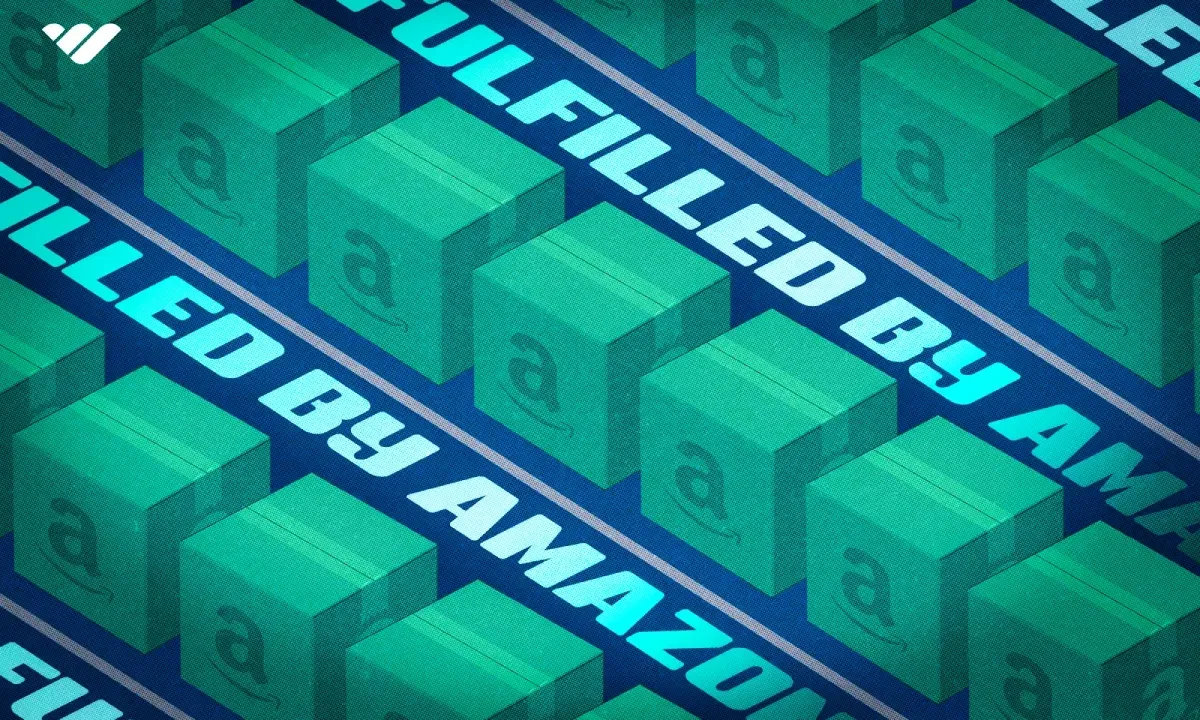
Amazon FBA is a method of selling your products on Amazon that involves you (the seller), Amazon the platform (the traffic source), and Amazon fulfillment centers (the place where your orders get fulfilled). The core idea of Amazon FBA is that the seller creates the products and Amazon ships them out to individual customers.
With Amazon FBA, the seller creates their unique brand or product, buys the inventory in bulk from their supplier, and then sends it to an Amazon warehouse. From there, the seller creates an optimized product listing on Amazon and starts generating sales. Amazon then picks, packs, and ships each order in its own iconic packaging and tracks them through its own tracking system.
This benefits both sellers and consumers because people have the ability to buy products with the convenience of Amazon (one app or website and one account, Prime Two-Day shipping, etc.) and, if necessary, can do returns and exchanges all while dealing solely with Amazon. Amazon also takes the stressful job of logistics away from the seller and handles it with its own infrastructure.
Amazon FBA: the Good and the Bad 🛒
Pros:
Existing Market & Amazon Prime
By selling on Amazon, you’re getting access to millions of shoppers who have already made purchases on Amazon. If people are searching for your product on Amazon then they’re likely ready to buy immediately and just want a good deal or the highest quality brand.
If you’re only selling on a direct-to-consumer website, then you’re responsible for bringing traffic to your site, which isn’t easy. This can be done in several ways, but they all require either a time or financial investment through organic marketing or paid advertising.
Plus, when you use Amazon FBA, your products are automatically in the Amazon Prime (free shipping and more benefits) ecosystem because they’re coming from Amazon’s own warehouses, not a separate location.
Fulfillment and Inventory Management
One of the best selling points of Amazon FBA is that sellers aren’t the ones responsible for getting orders to customers. Traditionally, ecommerce brands would have to ship the products themselves through their own warehouses or hire a third-party logistics company, both of which have high expenses and require massive energy investments because of the number of staff required.
Amazon handles monthly storage and fulfillment with Amazon FBA.
Higher Trust & Conversion Rate
Selling on Amazon automatically gives your brand a seal of approval that benefits customers. Shoppers already trust Amazon and their customer-first approach, so any sellers that are on the platform get built-in advantages.
Badges like “Buy with Prime” and free shipping will lead to higher conversion rates and more revenue, because potential customers know that if they buy they’ll get it faster than anywhere else online and if anything goes wrong, they have insurance from Amazon.
Customer Support
Amazon handles just about everything. Including communication with purchasers if something goes wrong. That means you don’t need to worry about shipping notifications, handling complaints, or returns if and when something goes wrong.
Cons:
Expensive Fees
When you sign up for Amazon FBA, Amazon has two fees: Monthly inventory fee and a per-item fulfillment fee. Each of these varies on how much space your products take up and how big they end up being for shipping.
These charges will greatly reduce your overall profit margin. (Convenience has a price!) Make sure you’re taking into account your cost of goods, overhead, and FBA fees when figuring out your pricing strategy.
Decreased Control Over Your Brand
Selling on Amazon and having them send out your packages reduces the level of brand experience you can offer customers. If you have special features on your site, tactics for bundling or upselling, or fancy packaging, you won’t be able to fully employ these when selling through Amazon FBA.
Amazon uses its own digital experience and physical packages for products fulfilled through its warehouses. Unfortunately, no cute animations or aesthetically pleasing boxes with Amazon FBA.
Lack of Transparency
Amazon FBA also limits how much you know about your customers, and how much your customers know about you. Customer data is one of the most valuable assets of any business, especially digitally-native ecommerce brands that use tools like pixels, cookies, and email lists.
Operating through Amazon FBA limits how much you can communicate with buyers and reduces your lifetime value as it’s harder to retain a client you don’t know much about.
Intense Competition
Because of the operational friction Amazon FBA takes away from sellers it simply makes operating an ecommerce business easier. Ease means lower barriers to entry and more players aiming to do the same thing as you.
Competition is fierce with Amazon FBA, whether it’s established brands or overseas suppliers. Consider targeting categories and niches that are under the radar and don’t garner as much attention.
Higher Return Rate
While conversion rates are higher, Amazon also makes returning items much easier. Selling on Amazon FBA lends way to more customers sending back unwanted orders compared to direct-to-consumer sites that don’t have as sophisticated return processes.
What is Dropshipping and How Does it Work?

Dropshipping is similar to Amazon FBA in that the seller isn’t responsible for physically handling the product, but there are plenty of differentiating factors.
Dropshipping is when a seller (typically a brand or store owner) sources a product from an overseas supplier from a platform such as AliExpress, drives traffic to their owned storefront (usually created on Shopify), and when an order is placed, the fulfillment is handled by the supplier.
With dropshipping, the store owner brings and converts customers on their website, but they’re selling a generic product that gets sent out from the wholesaler.
Dropshipping: the Good and the Bad 📬
Pros:
Creativity & Branding
Dropshipping lets you have much more control over how your brand is perceived in the market. Because your traffic comes from your own ads and goes to your own website, you get to choose the colors, fonts, visuals, etc.
This also gives you the ability to increase revenue through order value-boosting tactics like multipacks and upselling. Conversion rate optimization expertise can also come into play and help turn a higher percentage of visitors into paying customers. With Amazon, you’re not able to change anything about the on-site experience, but with dropshipping you can.
Employ Your Own Marketing Expertise
If you’re a pro media buyer or content creator, then you’ll benefit from the fact that you’re responsible for bringing more people into your sales funnel. You’re not limited to people only shopping on Amazon, but rather you can target anyone using the Internet.
Dropshipping will be most valuable to those who already have a solid understanding of how marketing and ad campaigns work.
Customer Data & Retention
With dropshipping, you own the relationship with your customers, not Amazon. This visibility allows you to talk with them directly and get feedback on your product line, customer service, and even get ideas for new products.
Retention marketing such as email or SMS is also easier to conduct with dropshipping. If you have customers’ contact information and they opt in to receive marketing messages, you can send them news, coupons, and new releases that’ll excite them and get them to buy from you more often.
Hands-Off Fulfillment
Perhaps the biggest advantage of dropshipping for online marketers is that you don’t need to send out the product yourself. With dropshipping, the supplier performs the same role that Amazon does in FBA.
Cons:
(Also) Hyper Competitive
No matter which business model you go with there will be competition. Dropshipping has been around for decades now, so the number of sophisticated sellers is only increasing.
The number of software and services readily available has also increased so more people can quickly spin up online stores with the next hot products.
Customer Service Management
Unlike with Amazon FBA, the seller is responsible for managing returns, exchanges, and questions. While it can mostly be done remotely, customer support is still an ongoing job that requires constant attention.
Consider how much involvement you want after the sale happens when deciding between Amazon FBA and dropshipping.
Lack of Quality Control
When you dropship a product you never really get to see how it turns out, unlike if you were to fulfill the order yourself. This makes consistent quality hard to measure and guarantee.
Make sure to only buy from experienced suppliers with a track record of happy customers and significant order volume.
What’s the Difference Between Amazon FBA and Dropshipping?
Outlining the differences between Amazon FBA and dropshipping can best be done by looking at each responsibility and seeing who covers each step between the two models. The three main functions of an ecommerce business are:
- Product: The item being sold
- Traffic: The potential customers
- Fulfillment: The warehousing, packing, and shipping
With Amazon FBA, the seller is responsible for creating the product and getting it to an Amazon distribution center. From there, Amazon brings the traffic and manages inventory, shipping, and customer service.
But through dropshipping, the seller is really only responsible for driving traffic to their online store and interacting with customers. The supplier (a wholesaler, middleman, or manufacturer) designs and develops the product and once sales come in, they manage the fulfillment from their warehouses. Though, the seller is still responsible for handling customer inquiries.
Can You Dropship on Amazon?
After reading all of this information, you may be wondering if you can combine the two models and dropship your products on Amazon’s website, and the answer is yes. If you follow all of Amazon’s guidelines and your geography's relevant laws and regulations, dropshipping on Amazon is totally allowed.
The main difference between traditional dropshipping and Amazon dropshipping is that the online storefront is Amazon.com, and Amazon is the party bringing the traffic. In some instances, operators may use both Amazon FBA and Amazon dropshipping to fulfill orders.
If a product sells fast then Amazon FBA would be best, because the product is already in one centralized location and Amazon can quickly get orders out the door. In the case of slow-moving SKUs, sellers prefer to dropship them so as to not pay the monthly warehousing fees.
Is Amazon FBA or Dropshipping Best for My Business?
Now that we know what both of these business models are, how do you decide which is best for you? Well, to start, both of these models are a great choice as they give you the ability to sell products online without being responsible for the actual order fulfillment. Plus, they can be done remotely.
For anyone who doesn’t have the warehouse space, desire to manage people, or experience in running a fulfillment operation, these businesses provide the opportunity to start an ecommerce brand without having to do this vital function.
Here are some other factors to take into consideration when choosing between Amazon FBA and dropshipping.
Amazon FBA: You Already Have a Brand
If you already have a thriving direct-to-consumer or brick-and-mortar business and you’re trying to reach new audiences, selling on Amazon offers you this opportunity. Selling on Amazon can be another way to further legitimize your brand presence while reducing the capital expenditure it takes to handle the influx of orders.
Dropshipping: You Want to Test Ideas
When you’re preparing to launch a long-term brand or your own unique product, dropshipping an existing model can be an effective strategy for testing the current market for it.
In just a few hours you can have a logo, online storefront, and run ad campaigns to see if people will click through to your website and ultimately convert.
Dropshipping: You Don’t Want to Invest a Ton of Capital
Amazon FBA requires you to send large quantities of your product to one of their fulfillment centers. But with dropshipping, you never have to buy inventory upfront. Rather, you only place an order with a supplier when someone has actually bought from your brand.
From a cash flow perspective, dropshipping is also super beneficial to store owners. Your money isn’t tied up in inventory so you can spend money on ads and scale your store quicker.
Amazon FBA Resources
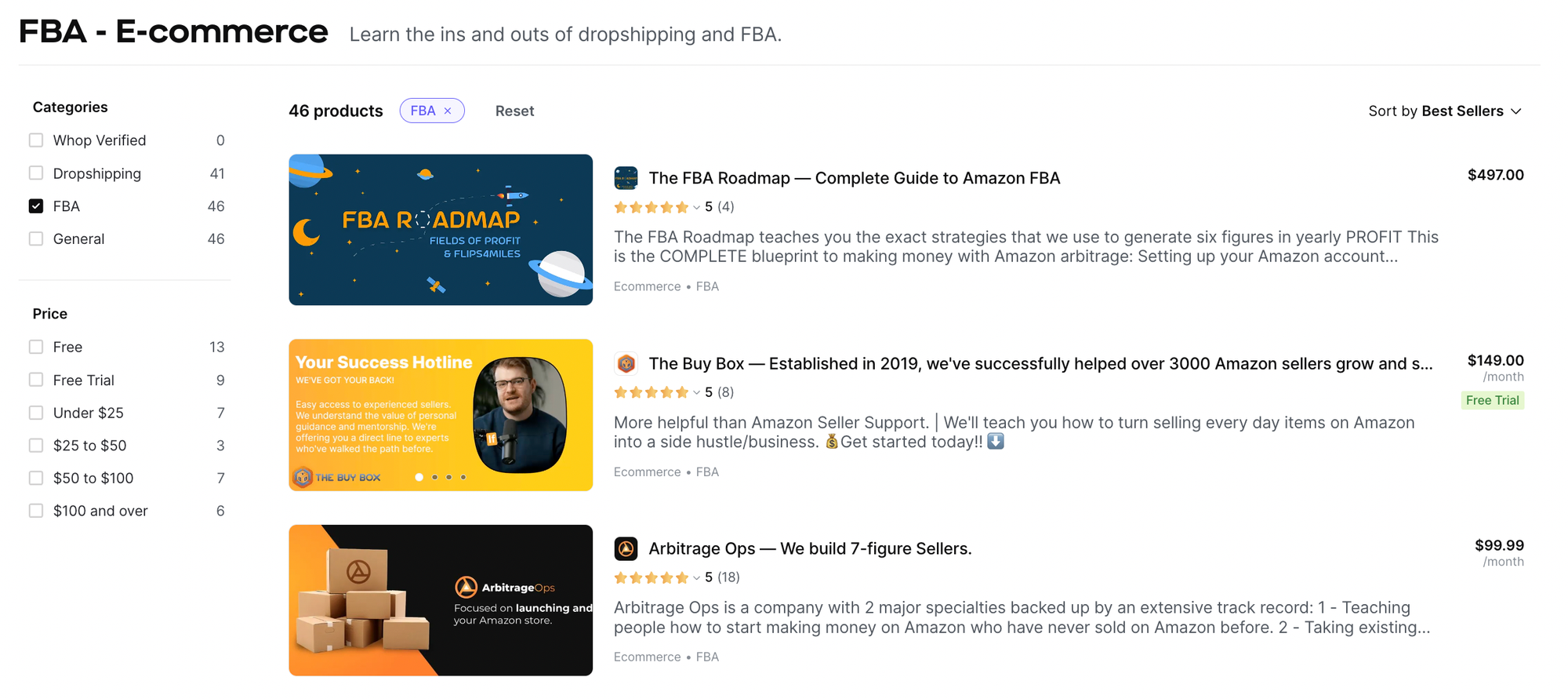
Amazon FBA is a tough business to master. While simple, it’s certainly not easy.
At Whop, we have dozens of courses and communities that teach you the fundamentals of Amazon FBA, product research, and how to create brands that Amazon shoppers love.
We recommend content like Arbitrage Ops and The Buy Box to help you get started on your journey. Both are taught by expert Amazon sellers and offer guides, content, and coaching.
Dropshipping Resources
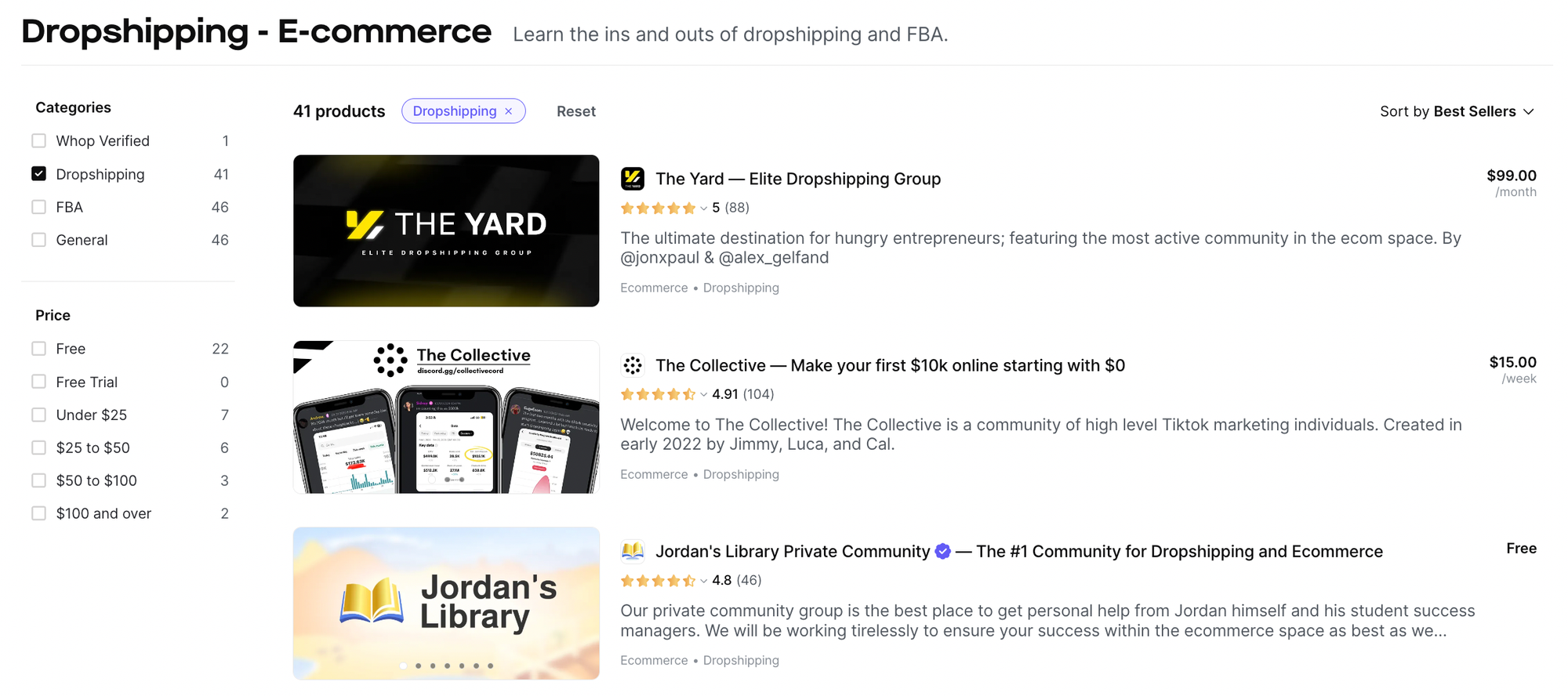
Dropshipping is one of the best ways to go from complete beginner to ecommerce expert with multiple different skills. From sourcing, Shopify, design, creative, and marketing, dropshipping can be a crash course in building a profitable and sustainable online business.
Our dropshipping communities teach everything from running Facebook Ad campaigns to finding reliable suppliers to build long-lasting fruitful relationships. Get one-on-one coaching, access to exclusive technologies, and connect with like-minded students today.
Amazon FBA and Dropshipping: Set Yourself Up for Success
Amazon FBA and dropshipping are some of the most popular online business models to start because of the limited capital and physical infrastructure they require to get started. Both systems take the operational burden of managing a warehouse away from the seller and place it on the partner, whether it’s Amazon or an overseas supplier.
These two ventures both require having a good product, taking customer feedback to improve, and driving traffic so that you can get sales. Amazon FBA is great because it has built-in distribution via Amazon’s thriving marketplace and dropshipping is advantageous because you have a direct relationship with your buyers.
Regardless of which one you choose, Whop has the best information to get you started. Simply head to the marketplace and explore the groups on offer to learn from the best and set yourself up for success.
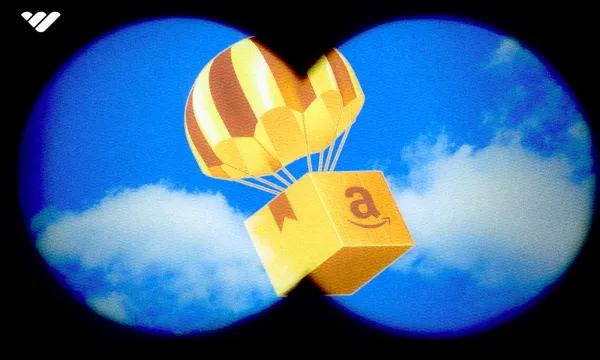

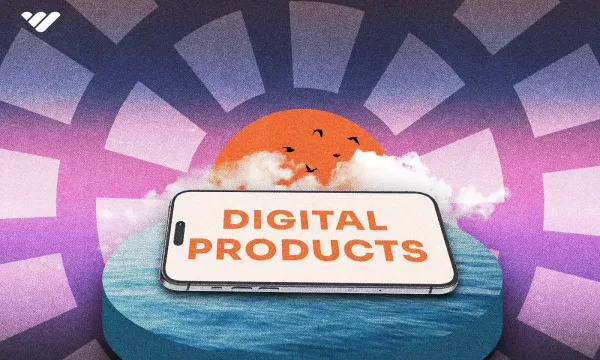
![Top 23 best dropshipping Discord Servers [July 2025]](/blog/content/images/size/w600/2024/02/Top-Dropshipping-Discord-Servers--1-.webp)
![Top 16 best ecommerce Discord servers [July 2025]](/blog/content/images/size/w600/2023/09/ecommerce-groups.webp)
